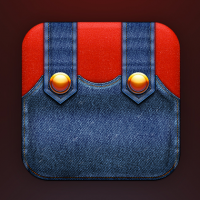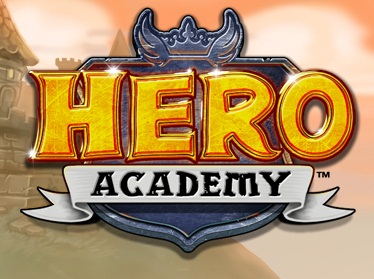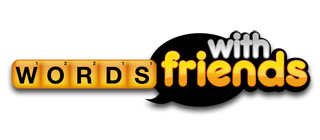Location-based games have had a number of notable titles over the years, as designers and developers have tried to gamify locations, or localize games, or whichever approach they feel like taking. While there are some notable exceptions, of course, the majority of these titles tend to follow this pattern: Continue reading Location-based Games and User Retention
Category: Games
Wii U to Ditch Friend Codes, Welcomes Convenient Social Gaming
One of my biggest gripes about the Nintendo Wii was the idea of having to jot down lengthy friend codes to play with friends and colleagues online. Talk about counterproductive measures to experience “social” gaming. However, earlier today, it was revealed that multiple user IDs will be able to be stored on the Wii U, which also means Friend Codes are now a thing of the past.
Sites like Destructoid are confirming that Nintendo has officially set the record straight, stating, “Our plan is to replace Friend Codes with a much more user-friendly Account ID system, which employs user-created account names.”
Finally, Nintendo has caught up to the consoles (and mobile devices for that matter), allowing quick, immediate connectivity to friends without the ridiculous number sequences previously required to connect. This just went a long way in getting me further intrigued in the Wii U’s launch, which is slated for November 18.
With a handful of launch titles featuring multiplayer capabilities, including Call of Duty: Black Ops II, Wipeout 3, FIFA Soccer 13, and Sonic & All-Stars Racing Transformed to name a few, you can bet friends looking to play together across the country breathed a collective sigh of relief around today’s Nintendo reveal – myself included.
Age of Aquarius: the video game industry at Comic-Con
Almost exactly ten years ago, I finished for the first time The Legend of Zelda: Ocarina of Time. It was that moment when I first identified as a gamer and felt a devotion to video games that I was at the time too young to understand. But over the next ten years, that devotion grew to become the incorporation of video games into my own being.
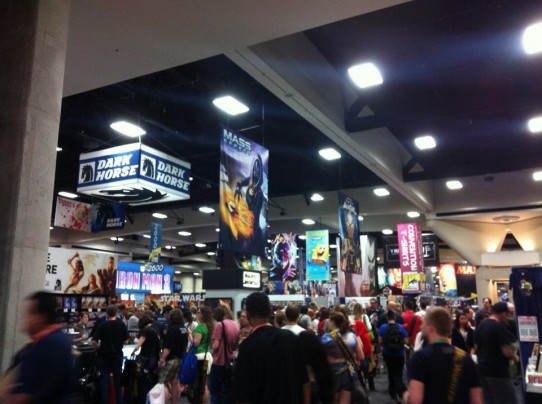 For keeping in touch with who I have become and investing in what is important to me, I obviously then felt a yearning to attend PAX and of course Comic-Con, which I knew was not focused on video games, but interested me nonetheless. What video game devotee wouldn’t want to see just how much video game fandom she could soak up at Comic-Con?
For keeping in touch with who I have become and investing in what is important to me, I obviously then felt a yearning to attend PAX and of course Comic-Con, which I knew was not focused on video games, but interested me nonetheless. What video game devotee wouldn’t want to see just how much video game fandom she could soak up at Comic-Con?
We are at a point in time when Comic-Con attendees no longer enter believing the show is about comics. That is not to say comics don’t have a strong presence at the show; one end of the hall was covered in nothing but DC and Marvel merchandise vendors. Attendees costumed as Thor, Spiderman, Superman, and Batman far outnumbered attendees dressed as video game characters (including myself). Still, one cannot ignore that the most crowded parts of the convention hall were around the likes of Fox and Warner Bros, and the most popular panels were any that featured Hollywood celebrities regardless of whether or not the panel was about a comic book movie.
We are also at a point in time where the fandoms of comics, movies about comics, movies and TV shows about fantasy worlds in general, cartoons, anime, manga, and video games have all collided, with the resulting explosion manifesting as the San Diego Comic-Con. But as I took my first steps into the convention center, I asked myself, how many video game companies might I find exhibiting on the show floor? Will they take up as much space as the fabled comics that started the show? Or, will they be shoved off to a corner where only the most hardcore of fans will bother to visit?
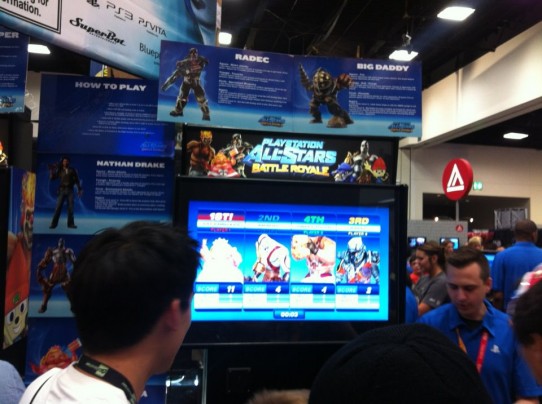 After pushing through the crowd surrounding the Fox and Warner Bros booths, I found Ubisoft, Activision, Nintendo, Square Enix, Sony, and Capcom nestled into one end of the convention hall. Each game demo station was populated, each with a player and a crowd of onlookers. I later learned Nintendo and Ubisoft had the rest of their games featured at Nintendo’s game lounge next door, SEGA and Microsoft had set up across the street, and BioWare had their own station at the Hilton two blocks away. After visiting each booth, each game lounge, and finding a wealth of merchandise from my favorite video games from vendors on the show floor, I continued each day satisfied with the presence of video games at the show.
After pushing through the crowd surrounding the Fox and Warner Bros booths, I found Ubisoft, Activision, Nintendo, Square Enix, Sony, and Capcom nestled into one end of the convention hall. Each game demo station was populated, each with a player and a crowd of onlookers. I later learned Nintendo and Ubisoft had the rest of their games featured at Nintendo’s game lounge next door, SEGA and Microsoft had set up across the street, and BioWare had their own station at the Hilton two blocks away. After visiting each booth, each game lounge, and finding a wealth of merchandise from my favorite video games from vendors on the show floor, I continued each day satisfied with the presence of video games at the show.
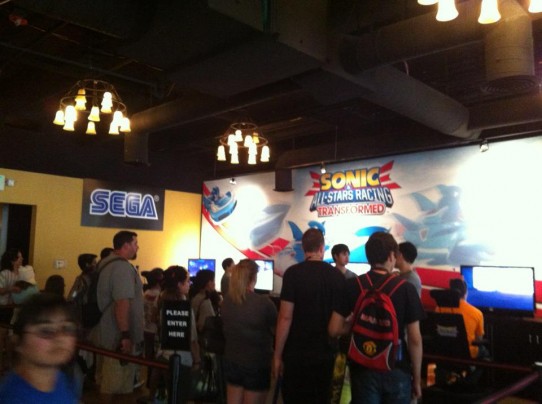 As a gamer and a fan, I believe my trip to Comic-Con was fruitful. I got to demo new games. I bought a wealth of fun merchandise (video game and non-video game alike) and received generous VIP gifts (a Sonic comic from Sonic Boom seemed fitting). I got to reconnect with video game industry people who were equally as enthusiastic about the show. I got to see how video games had joined the cultural lexicon. I got to take a memorable vacation to a consumer show with friends whom I grew closer to. And most of all, I was reminded of how the gamer in me grew into the person I am today. This was not done via the games I demoed, the swag I obtained, the parties I attended, or the characters I dressed up as, but by coming to this realization ten years later.
As a gamer and a fan, I believe my trip to Comic-Con was fruitful. I got to demo new games. I bought a wealth of fun merchandise (video game and non-video game alike) and received generous VIP gifts (a Sonic comic from Sonic Boom seemed fitting). I got to reconnect with video game industry people who were equally as enthusiastic about the show. I got to see how video games had joined the cultural lexicon. I got to take a memorable vacation to a consumer show with friends whom I grew closer to. And most of all, I was reminded of how the gamer in me grew into the person I am today. This was not done via the games I demoed, the swag I obtained, the parties I attended, or the characters I dressed up as, but by coming to this realization ten years later.
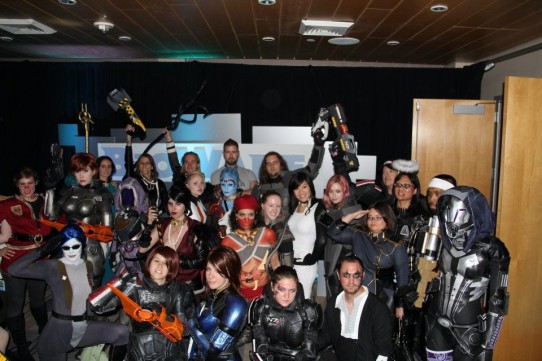 I have heard the multi-genre fiesta that is Comic-Con described as a “nerd Woodstock.” Unlike trade shows like E3 and video game-focused consumer shows like PAX, Comic-Con encourages people of multiple interests to come together and “celebrate the popular arts,” as proclaimed by the Wreck-It Ralph banners on each San Diego street. As someone whose being lies predominantly in the gaming realm of Comic-Con’s pot of genre stew, I wondered if the video game companies who exhibited off the show floor this year would be inside the convention center next year. And, for video game companies who exhibit on the show floor annually, I wonder if they will build their Comic-Con presence over the years. Will that draw more gamers to the show? Will that raise the interest of non-gamers who might want to learn more about video games and video game culture? Will it tip the balance of Comic-Con as a multi-genre gathering towards a more game-oriented event? Or, will it simply boost the video game industry’s positioning as just that: a popular art?
I have heard the multi-genre fiesta that is Comic-Con described as a “nerd Woodstock.” Unlike trade shows like E3 and video game-focused consumer shows like PAX, Comic-Con encourages people of multiple interests to come together and “celebrate the popular arts,” as proclaimed by the Wreck-It Ralph banners on each San Diego street. As someone whose being lies predominantly in the gaming realm of Comic-Con’s pot of genre stew, I wondered if the video game companies who exhibited off the show floor this year would be inside the convention center next year. And, for video game companies who exhibit on the show floor annually, I wonder if they will build their Comic-Con presence over the years. Will that draw more gamers to the show? Will that raise the interest of non-gamers who might want to learn more about video games and video game culture? Will it tip the balance of Comic-Con as a multi-genre gathering towards a more game-oriented event? Or, will it simply boost the video game industry’s positioning as just that: a popular art?
Though I refuse to make an argument for whether or not video games are art, I want to know how video game companies themselves feel about Comic-Con’s role in the video game industry, whether the industry can be celebrated there like it is at PAX, and whether video games will continue to have as much or more presence as comic books, movies, and the other media at Comic-Con.
Whatever the future holds for the presence of video games at Comic-Con, we can safely assume the next ten years will only keep San Diego as the center of the Aquarian Exposition of Comics, Movies, Anime, Manga, and Video Games. And for now, I can at least say I’m proud to be a part of the video game industry’s involvement in the movement for peace and love across all fandoms.
Mobile Game Design – Don’t Forget the Basics
Congratulations on taking the plunge into the mobile games market! No doubt it’s been a remarkable and difficult journey for you and your game, but the design is nearly perfect, and you’re ready to share your creation with the world. Mobile games have come a long way since we first figured out how to put Tetris on our graphing calculators in high school, and it’s an exciting field that’s evolving and improving every day.
Sadly, when you dwell exclusively on the cutting edge of game development, it’s easy to lose sight of the basics. There are a few core tenets of mobile design that should be prerequisites for publishing nowadays, yet every so often, even the most experienced of developers forget them. No matter how impressive the graphics or how amazing and innovative the controls are in a game, it pains us when designers still get some of the basics wrong after all these years. Continue reading Mobile Game Design – Don’t Forget the Basics
Part of Me: On the Smithsonian’s Art of Video Games
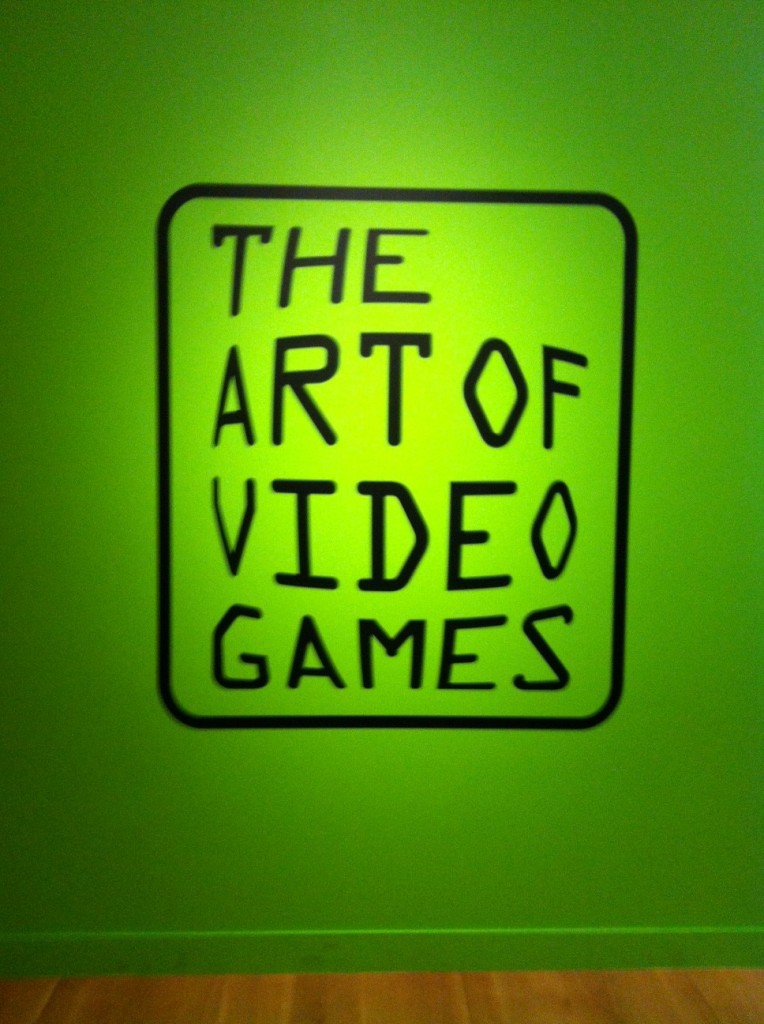
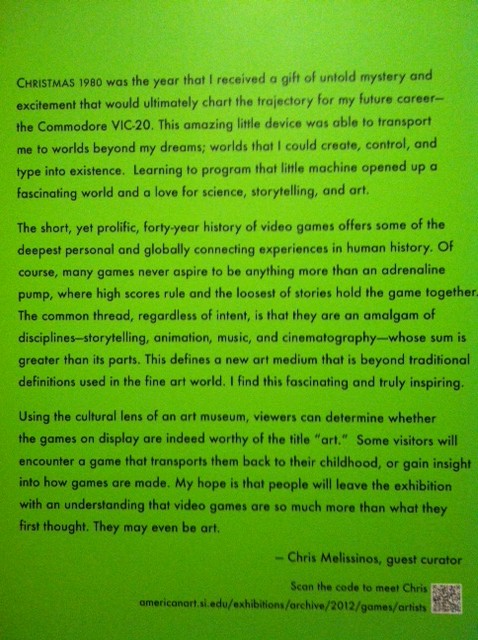 In the farthest reaches of the Smithsonian, at the end of a dark corridor, was a large screen indicating the entrance to the Art of Video Games exhibit. On the large screen were snippets of video game cut-scenes from various video games, old and new, from Pac-Man to Heavy Rain. What really caught my eye were not the images on the screen but the statement by guest curator, Chris Melissinos.
In the farthest reaches of the Smithsonian, at the end of a dark corridor, was a large screen indicating the entrance to the Art of Video Games exhibit. On the large screen were snippets of video game cut-scenes from various video games, old and new, from Pac-Man to Heavy Rain. What really caught my eye were not the images on the screen but the statement by guest curator, Chris Melissinos.
Last month, Destructoid’s Ryan Perez expressed his disdain for the industry’s need to validate itself by calling video games “art.” Mr. Perez notes at the beginning of his article that he is neither the first nor the only one to be tired of the “games as art” argument. I personally never bothered to validate video games as art or not art as I felt that if a medium—an experience—could mean so much to me and be such an important part of myself, does it really matter if the public believes it to be art or not?
 I believe this to be the reason why I was refreshed to see the words written on the wall. In three short paragraphs, Chris Melissinos explains the importance of video games in his life, as some of the deepest personal and globally connecting experiences in human history. More importantly, Mr. Melissinos makes it clear that the exhibit was not created to educate viewers on why video games are art, but for viewers to make that decision for themselves, that video games “may even be” art.
I believe this to be the reason why I was refreshed to see the words written on the wall. In three short paragraphs, Chris Melissinos explains the importance of video games in his life, as some of the deepest personal and globally connecting experiences in human history. More importantly, Mr. Melissinos makes it clear that the exhibit was not created to educate viewers on why video games are art, but for viewers to make that decision for themselves, that video games “may even be” art.
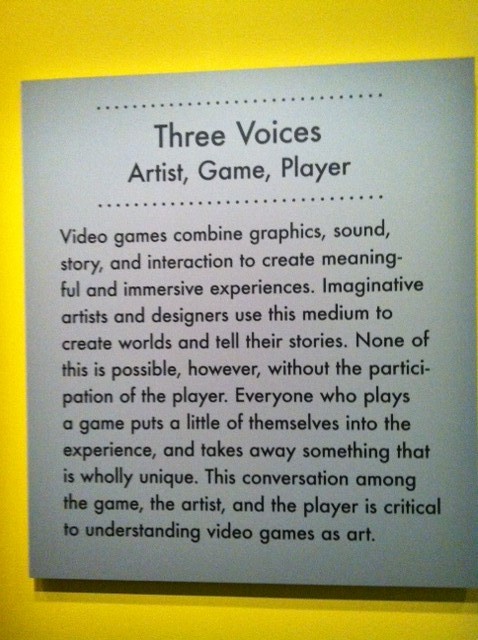 The adjacent room, with concept art from a few games and videos of facial expressions captured while playing, housed a small gray panel which explained the goal of the exhibit further.
The adjacent room, with concept art from a few games and videos of facial expressions captured while playing, housed a small gray panel which explained the goal of the exhibit further.
If I had ever argued that games are art, it was because I believed the definition of art was any piece that made a bold statement that resonated with me when I viewed it. I wondered after reading this panel if Mr. Melissinos wished viewers to leave the exhibit believing games to be art, while still allowing them to come to the conclusion themselves.
 I believed that to be the case when I saw the next room, which was filled with demos of games from the original Super Mario Bros. to The Secret of Monkey Island to thatgamecompany’s Flower. Visitors were invited to play through a few minutes of each of those games in the hope that it would either bring back fond memories or help non-gamers understand the meaning of video games and the experiences they offer. Though I could not read what each player in the room was thinking when they were playing, I knew this room was intended to complete the equation explained in the gray panel: the conversation among the game, the artist, and the player.
I believed that to be the case when I saw the next room, which was filled with demos of games from the original Super Mario Bros. to The Secret of Monkey Island to thatgamecompany’s Flower. Visitors were invited to play through a few minutes of each of those games in the hope that it would either bring back fond memories or help non-gamers understand the meaning of video games and the experiences they offer. Though I could not read what each player in the room was thinking when they were playing, I knew this room was intended to complete the equation explained in the gray panel: the conversation among the game, the artist, and the player.
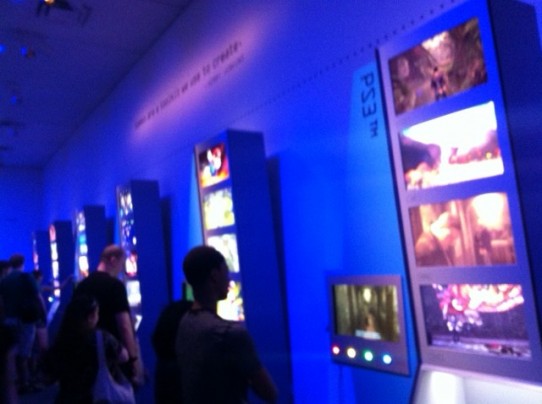 The final room of the exhibit had a timeline of consoles on display, with video clips from games of different generations from the Atari VCS to the PlayStation 3. After getting my dose of knowledge and nostalgia (and an array of new photos in my camera), I wondered if the hundreds of strangers around me actually believed games are art, refused to believe they are, or were indifferent of the answer. Did each visitor fulfill Chris Melissinos’s goal of at least deliberating the question?
The final room of the exhibit had a timeline of consoles on display, with video clips from games of different generations from the Atari VCS to the PlayStation 3. After getting my dose of knowledge and nostalgia (and an array of new photos in my camera), I wondered if the hundreds of strangers around me actually believed games are art, refused to believe they are, or were indifferent of the answer. Did each visitor fulfill Chris Melissinos’s goal of at least deliberating the question?
I took one last look at the gray panel: Three Voices—Artist, Game, Player. In this instance, the Artist is the game developer, the Game is the physical product created by the developer, and the Player is the consumer; the one experiencing the game. As I read the passage one more time, the definitions of each voice began to blur in my mind. I believed this to be the goal of the exhibit as well: to allow viewers—the players—to insert themselves into the concept art they saw, into the game demos on display, and into the memories that returned when looking at the different generations of consoles and games. Though we will never know what exactly emerges within each visitor, we can safely assume that each is wholly unique.
Personally, I still do not believe there is a universal truth on whether or not games are art. I could write an entirely separate piece arguing for the importance of the medium, but for now, I have at least come to this conclusion:
Each visitor of the exhibit is the creator of what they took away and of what they believe video games are to them. I chose to focus on what video games have made me and why I chose to agree with Chris Melissinos’ beliefs on the sacred bond the player makes with the game. For these reasons, I believe that the conversation between the game, the artist, and the player—and the blurring of the lines separating the three—brings about a fourth voice. And it is for these reasons that the identity of the fourth voice is up to the player to decide.
Surviving E3 2012
Whether or not E3 is still the games industry’s foremost gathering, or whether that honor has been usurped by shows like GDC or PAX, one thing about E3 remains true every year: It’s nuts. Whether you’re an exhibitor or a reporter, you can expect to run yourself ragged, staying on your feet for hours on end, scrambling to meet your various appointments while trying to wedge in just one more meeting in between the big presentations. Then, you’ll try to see just how much socializing you can do while trying to finish the rest of your workload that evening — assuming the Wi-Fi works in your hotel room — and convince yourself that 4 hours of sleep will be enough to let you get up and do it all again the next day.
This pattern of self-inflicted abuse is true for most conventions and expos, of course, but the brutal traffic of Los Angeles and the mainstream appeal of the biggest names in gaming makes E3 especially trying for even the most seasoned attendee. Thankfully, your friends at TriplePoint are here with another helpful set of tips and reminders to help ease the pain of next week’s quagmire. Continue reading Surviving E3 2012
Nintendo’s Battle for a Dedicated Gaming Platform: Throw In the Towel for Mobile?
Nintendo has been facing an incredible amount of pressure from existing and new entrants to the gaming space that has led to a decline of its market share. With only so much time in one day to consume media, consumers have a choice between “core” gaming, by way of consoles and PCs, and a more casual experience via browser and on mobile devices; Nintendo has found itself at the service of neither audience.
With the impending launch of Wii U, the company has taken a public stance in support of the core gamer, but is faced with overcoming the challenge of offering a superior online experience to the established leader in the space, Microsoft and its Xbox 360. Its track record with Wii Shop leaves many of us doubtful that it can rebound in this sense. Meanwhile, the mainstream audience that helped propel Nintendo to success in the last decade with the Wii is being abandoned in favor of more costly hardware and complicated controls of the Wii U.
Clearly, Nintendo’s platform is at risk of failure, and investors and Mario fans alike are clamoring for a shift in strategy. Most notable among the call for action lies with the leader and renowned innovator in software and hardware – Apple. Prior to iOS, we had terrible interfaces that were counterintuitive to driving engagement of content and considered a 5% market penetration of games as a success. Since the debut of iOS and the App Store, we’ve seen the market expand to over 600,000 applications and indie developers rising to fame, claiming thousands in revenue, and in some cases millions. Google Play trails closely behind with over 500,000 applications available, although the platform faces piracy issues that leave it second to iOS in terms of developer support.
The new market opportunity is in mobile gaming, as Apple and Google continue to seed global audiences with smartphone devices that spur user engagement with various forms of content, most notably games. Should Nintendo bow to market pressures and take Mario, Zelda and Metroid to mobile devices? Certainly not now, without sacrificing its entire platform and affecting its remaining grip on the game enthusiast market. Let’s analyze the implications of what can be seen as a rash decision in several ways.
Shifts in Revenue
Nintendo’s revenues have taken a hard hit as a result of our shift to mobile platforms. Wii owners are largely content with Wii Sports, and those mainstream consumers have hardly converted into purchasers of additional software, resulting in decreased developer support. The 3DS launched to a cold welcome, but has since slashed prices and achieved moderate success among a stagnant core gaming audience.
 The company recorded its first operating loss of $460 million for fiscal year ending March 31st, much of which can be attributed to the struggling Wii console, DS and 3DS, all falling short of sales expectations and incorporating price cuts in response to increased competitive pressures. We can also assume that much of the capital was allocated to continued support for game developers on each platform and R&D towards Wii U.
The company recorded its first operating loss of $460 million for fiscal year ending March 31st, much of which can be attributed to the struggling Wii console, DS and 3DS, all falling short of sales expectations and incorporating price cuts in response to increased competitive pressures. We can also assume that much of the capital was allocated to continued support for game developers on each platform and R&D towards Wii U.
Meanwhile, Rovio released its 2011 earnings statement, highlighting $67.6 million in profit on $106.3 million in revenues that can be largely attributed to its Angry Birds property, 30% of which came from merchandising and licensing. Based on these numbers, we can estimate that around $70 million was generated by downloads of Angry Birds. Impressive numbers indeed and deserving of praise for the company’s immense success across the various platforms on which Angry Birds can be found.
Yet, Angry Birds is at the top of the food chain, and few (if any) can come close to matching the success that Angry Birds has seen. And in comparison to Nintendo’s current business, it fails to match the numbers of its own game platform business.

For fiscal year beginning April 1, 2012, Nintendo is expected to achieve $500 million in operating profit according to a forecast estimate compiled through a survey of 20 analysts by Thomson Reuters I/B/E/S. The company controls its own fully integrated platform specifically tailored to gaming, similar to Apple’s hardware/software strategy that spans personal computers and mobile devices, not to mention the impending launch of the rumored iTV. Nintendo sells the hardware and controls the pipeline of software making its way to consumers, consisting of its own popular IP and an ecosystem of developers from which it generates additional revenues with every game purchase.
 Let’s take a look at another example, one that would be on the lower end of Nintendo’s sales figures on a platform that is largely characterized as “struggling” – Mario Kart 7 on the 3DS. The title has so far achieved global sales of nearly 5.5 million units, running at $39.99 a pop. That’s nearly $220 million in revenues, over double Rovio’s business. Now, the margin on packaged goods isn’t really as significant, but even if we’re looking at a 20% profit margin, we’re talking about approximately $44 million in profit from a single title that has been on the market for only 6 months and on hardware that isn’t even considered a mainstream success. Looking forward, it’s not a stretch for Nintendo’s hardware to go strictly digital as industry trends indicate and eliminating the packaged goods channel, increasing margins and generating even greater profits (considering a premium price point maintained through “deeper” gaming experiences of Nintendo hardware). Also, this is just for one title – consider all the other games moving through the 3DS, controlled 100% by Nintendo and generating even greater revenues from both 1st and 3rd party games.
Let’s take a look at another example, one that would be on the lower end of Nintendo’s sales figures on a platform that is largely characterized as “struggling” – Mario Kart 7 on the 3DS. The title has so far achieved global sales of nearly 5.5 million units, running at $39.99 a pop. That’s nearly $220 million in revenues, over double Rovio’s business. Now, the margin on packaged goods isn’t really as significant, but even if we’re looking at a 20% profit margin, we’re talking about approximately $44 million in profit from a single title that has been on the market for only 6 months and on hardware that isn’t even considered a mainstream success. Looking forward, it’s not a stretch for Nintendo’s hardware to go strictly digital as industry trends indicate and eliminating the packaged goods channel, increasing margins and generating even greater profits (considering a premium price point maintained through “deeper” gaming experiences of Nintendo hardware). Also, this is just for one title – consider all the other games moving through the 3DS, controlled 100% by Nintendo and generating even greater revenues from both 1st and 3rd party games.
For Nintendo to trash its own closed gaming platform for Apple’s in pursuit of revenues that have not publicly achieved the scale that Nintendo currently maintains just doesn’t add up. It’s also understandable that Nintendo derides the thought of having to pay Apple the 30% cut, which would make it an even greater challenge to achieve success on the scale of its current games business. A counter argument to this is that Nintendo can offer games on each platform, which doesn’t come without merit, but let’s take a look at this audience.
Can Mario Wear Different Hats?
 For Nintendo to reach the scale of success on Apple’s platform that it currently achieves within the confines of its own closed platform, let’s assume two scenarios: 1) that the game experience is rich enough to sell on the level of Angry Birds (that’s 1 billion downloads!), or 2) that Nintendo sells at a premium with less market penetration. Both situations would have to involve the creation of new games based on its popular IP, rather than a direct port of old games which would only have a minimal impact on Nintendo’s bottom line, not to mention potential disappointment in the controls for some of our most favorite classics that were built for console controls.
For Nintendo to reach the scale of success on Apple’s platform that it currently achieves within the confines of its own closed platform, let’s assume two scenarios: 1) that the game experience is rich enough to sell on the level of Angry Birds (that’s 1 billion downloads!), or 2) that Nintendo sells at a premium with less market penetration. Both situations would have to involve the creation of new games based on its popular IP, rather than a direct port of old games which would only have a minimal impact on Nintendo’s bottom line, not to mention potential disappointment in the controls for some of our most favorite classics that were built for console controls.
The first scenario would be largely targeted at the expanded mainstream audience, one that Nintendo did a great job of penetrating with the Wii and DS. Yet, we have to ask ourselves if the casual gamer of an older demographic and one that skews female would be willing to purchase a Nintendo device if Mario could be had on an iPhone, iPod touch or iPad. Facing limited time in one’s day, chances are that this gamer would skip the purchase of a game-dedicated device and invest $0.99 on a more casual Mario experience. Asking my wife and her 21 year old sister if they’d purchase a new Mario for Wii if they had Super Mario World on their mobile device, they both confidently answered “no way, the app would be good enough”. This would affect the purchasing decision of millions of consumers and cannibalize Nintendo’s gaming platform at a much more significant loss than what it can possibly recover in $0.99 downloads. This isn’t a risk that Nintendo can afford to make, at least not right now.
The second scenario involves a very challenging balancing act of pricing games at a premium, say $9.99, and selling through enough downloads to generate a return on development costs. This would carry an even greater risk of cannibalizing Nintendo’s own platform as these premium games would also come with a deeper and richer gaming experience that could potentially directly compete with Wii U, DS and 3DS game quality. If I have a great Mario title on my mobile devices at $9.99, chances are that I’ll skip the dedicated hardware and $50 price tag for the game.
Additionally, either decision would send a very negative signal to the remaining developers who still believe in Nintendo’s gaming platform, causing additional speculation about those consoles’ impending demise, an even further loss of support in game development, and all but hammering the final nail in the coffin of Nintendo’s platform.
Finally, do we really want an innovator in the gaming space to drop what it does to hop on the iOS bandwagon and solely rely on a touchscreen interface? Is the future of gaming really only about the touchscreen, perhaps with gesture and voice recognition integrated within? Imagine where gaming would be now if Nintendo bowed down to economic pressures back when the GameCube was being labeled as a failure and the Wii and DS never happened. All those Wine, Cheese and Wii parties would have never happened, and one could fairly assume that the Kinect and Move gaming experiences may not have been inspired into market release, perhaps confined to TV integration and never having impacted the games we play.
“Tiiiime Is On My Side, Yes It Is”
 Mick Jagger’s voice resonates in my head as I read that Nintendo is sitting on a pile of cash amounting to $14 billion. Not only is Nintendo expected to turn a profit for fiscal year 2012/13, but it has a war chest to conceive and define the “next generation of gaming” through a fully integrated hardware and software platform, one that’s made exclusively for gamers and consumers seeking a good time. Even though the new Wii U doesn’t spur much hope with industry analysts and other market players, such efforts would be completely lost if confined solely to the hardware and interface design choices of Apple, a company whose business is far greater than the games sector to justify a focus on giving us new ways to experience video games.
Mick Jagger’s voice resonates in my head as I read that Nintendo is sitting on a pile of cash amounting to $14 billion. Not only is Nintendo expected to turn a profit for fiscal year 2012/13, but it has a war chest to conceive and define the “next generation of gaming” through a fully integrated hardware and software platform, one that’s made exclusively for gamers and consumers seeking a good time. Even though the new Wii U doesn’t spur much hope with industry analysts and other market players, such efforts would be completely lost if confined solely to the hardware and interface design choices of Apple, a company whose business is far greater than the games sector to justify a focus on giving us new ways to experience video games.
But how much time does Nintendo really have to make a decision? Even with $14 billion to cover years of operating costs, Nintendo can’t afford to sit around forever. A fair guess at the amount of time that Nintendo has to evaluate the marketplace and give a shot at maintaining a unique gaming experience lies perhaps in the 5-10 year range. Most everyone will understandably argue that this is too much time, but Mario, Zelda and Metroid aren’t going anywhere, and if Nintendo’s own platform faces a demise there will always be an audience ready to pounce on these titles when made available on iOS, Android or any other platform outside the company’s own walls.
Atari, who is celebrating its 40th anniversary this year, has hit a milestone of 10 million downloads just a year after releasing a number of classic and new games based on its renowned IP. Even decades after spending my hard earned weekly allowance in the arcades on Missile Command, Asteroids and Super Breakout, I can count myself among the millions that are downloading these games on iOS and Android (disclaimer: Atari is a TriplePoint client). You can bet that team Mario will have a lasting impact on consumers and maintain brand recognition that results in downloads 5-10 years down the road.
Losing Share to Angry Birds
 Kids everywhere are wearing Angry Birds shirts and socks, while plushies continue to fill the rooms of children around the world. The ~$30 million merchandising/licensing business around this IP is a strong indicator that the property is capturing the mindshare of consumers, certainly at a loss for Mario. This perhaps is the greatest challenge facing Nintendo the longer it waits to nail down and execute a strategy for distribution on iOS and Android. Yet, the company has a history of bringing fans of its various 1st party IP a reason to buy back into the franchises, and the continued power of those brands will no doubt ensure that it continues to sell hardware and games, and that the expanded audiences take notice as well, even if these casual audiences may no longer be willing to purchase a Nintendo gaming device.
Kids everywhere are wearing Angry Birds shirts and socks, while plushies continue to fill the rooms of children around the world. The ~$30 million merchandising/licensing business around this IP is a strong indicator that the property is capturing the mindshare of consumers, certainly at a loss for Mario. This perhaps is the greatest challenge facing Nintendo the longer it waits to nail down and execute a strategy for distribution on iOS and Android. Yet, the company has a history of bringing fans of its various 1st party IP a reason to buy back into the franchises, and the continued power of those brands will no doubt ensure that it continues to sell hardware and games, and that the expanded audiences take notice as well, even if these casual audiences may no longer be willing to purchase a Nintendo gaming device.
When all is said and done, nothing can sway Nintendo from sitting on its bankroll to continue attempts at innovating gaming fun as we know it, not as long as the market opportunities in mobile fall short of the rewards of maintaining its own closed gaming platform. A company that has over 120 years of history shouldn’t be swayed so easily by market pressures to ditch its game-focused platform for a new market that has been hot during the past 4 years (App Store launched in 2008). A survivor of the turbulent gaming market in the 90s and one that has stood up to Microsoft and Sony, we should be cheering on Nintendo to come up with a fresh gaming experience that takes us beyond a simple touchscreen interface dominated by a company that (understandably) deprioritizes gaming among all forms of digital media. Mario and team may one day land on our mobile devices, but considerations for its existing business should be taken into account, and we’ll always be ready to download Nintendo’s games years down the road.
Bourbon Cupcakes, BBQ, and a Sense of Community at the East Coast Game Conference
Two weeks ago, hundreds of game industry professionals and industry hopefuls gathered for the fourth installment of East Coast Game Conference in Raleigh, North Carolina. While the southeast doesn’t quite have the bustling industry reputation of San Francisco or Los Angeles, attendees didn’t seem to mind in the least. That a show planned almost entirely by a board that has separate full-time jobs, competing with giant expos that bring in 30 to 70 thousand people, continues to thrive says a lot about the industry today.
The expo hall, much like the show’s attendees, featured a unique split of well-established companies (Insomniac, Funcom, Red Storm), growing independent developers (Spark Plug Games, Mighty Rabbit), and industry-focused businesses, all rubbing elbows as they showed off their work and wares. Panels and presentation topics ranged from business to mobile and social gaming, along with a standalone track led by the region’s most recognizable name: Epic Games.
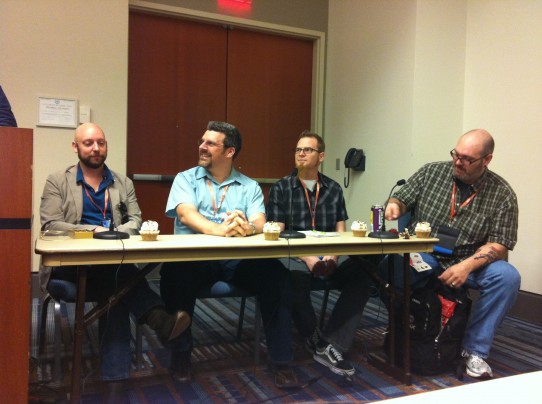 Of these varied panels, one in particular provided some helpful insights into the continually evolving relationship between consumers, journalists, and public relations in the gaming industry. Within trappings of bourbon cupcakes and actual bourbon, covered to great effect by Kotaku’s esteemed Mike Fahey here, editors from Polygon, The Escapist, Kotaku, and IGN spent an hour going over some of the tougher ethical questions they face in their work.
Of these varied panels, one in particular provided some helpful insights into the continually evolving relationship between consumers, journalists, and public relations in the gaming industry. Within trappings of bourbon cupcakes and actual bourbon, covered to great effect by Kotaku’s esteemed Mike Fahey here, editors from Polygon, The Escapist, Kotaku, and IGN spent an hour going over some of the tougher ethical questions they face in their work.
At the end of the final day, as the expo hall closed and the last panels wrapped up, the unique spirit of the NC Triangle’s gaming industry became a bit more apparent. Attendees lingered and chatted as they broke down their booths, some helping others as they packed up to head home and very few seeming in a huge rush to leave.
While it’s true that hubs like SF and LA lead the industry in size, there’s a lesson to be learned in the continued success of the ECGC. No matter how competitive the space gets, or how much worry goes into predicting the future landscape, we’re all in this together in the end.
Oh, and one more extremely important takeaway from the show: bourbon before noon can be dangerous. Drink responsibly, and preferably a bit later in the day. Cupcakes optional.
Adventures in Hindsight
The games industry hasn’t been able to get enough of Kickstarter since Tim Schafer and Double Fine managed to pull together $3.3 Million for an as-yet-nonspecific adventure game title. The story has given everybody a new theory about what is possible with regards to game publishing: esoteric designs and genres finally have a way to get around cautious publishers. The adventure game is not dead. Gamers will gladly pay a reasonable price if their wishes are being met. Finally, game design can be a true meritocracy.
These are mostly exaggerations, mind you. Not every aspiring game developer gets to be Tim Schafer, with an existing track record of critically acclaimed games and significant cachet among press and fans. Double Fine may have raised an incredible sum, but there have been plenty of also-rans who have failed to magically capitalize on this amazing new source of revenue. Continue reading Adventures in Hindsight
Playing in an Asynchronous World
The recent rise of mobile as a key platform in the gaming space is accompanied by meteoric growth in asynchronous gameplay. Not what you typically envision when hearing of the latest “multi-player videogame,” asynchronous games do not require the two or more participants to be playing simultaneously; rather, players make turns at their convenience. Chart toppers such as Words With Friends, Hero Academy and Draw Something have millions of people around the world playing asynchronous games daily.

The appeal of this detached gameplay mode on the mobile platform is obvious: by not having to participate “in-sync,” players are free to go about their day, logging in to make a move only when it’s convenient. Growing up, getting a quick game of StarCraft going with my friends required planning in advance to ensure everybody was free (or hoping they were signed into Ventrilo). Now the rich, social experience of multiplayer gaming is available anywhere, anytime, and with any of your hundreds of Facebook friends.
Without a doubt, asynchronous gameplay is bringing millions of new gamers online. Everybody from busy professionals to even busier moms can find time throughout the day to glance at their phones and lay down a quick 20-point word or crudely sketch a sunflower for their friends. These types of people that could never carve out a two-hour block of time to delve into the latest RTS or explore the world of a new MMO are exactly the target audience for asynchronous games.
Recently, I became completely addicted to Zynga’s Words With Friends. My phone buzzed constantly with updates – after all, with 10 or 15 games happening simultaneously, there’s always somebody free to play. I am, and imagine I always will be, a huge Scrabble fan, and my initial enthusiasm motivated the first few weeks of play. However, after a few months of playing WWF, I found myself oddly numb to the experience. Sliding my finger across each subsequent “New Move” notification pop-up seemed more and more of a chore and less about enjoying the game. I was no longer playing because I was immersed in the game, but rather because felt beholden to making the next move so my friends would not be left hanging.
A few months back, I finally snapped out of my daze and started reflecting on the experience, ultimately concluding that I expected too much of asynchronous gameplay. Like most of my daily electronic information flow, the game simply became another source for that short, addicting burst of serotonin so many of us crave in the Digital Age, with little to gain that could not be found in a casual glance at Twitter.
I may think that I’m a busy person and at times certainly am, but I’m no mom rushing kids to soccer practice and dance recitals. In retrospect, I probably spent close to two hours a day keeping up with WWF – not exactly a “non-disruptive” amount of time. Keep in mind, this was not two hours I scheduled specifically for play, but like with most players, time taken in small increments throughout the day that quickly added up to the point of distraction. This most convenient form of gaming was not only sucking an hour or two out of each day, but also doing so when I should have been focusing on work or enjoying the company of friends.
A few months free of Zynga’s iron grip and I’m making a point to schedule time for the sort of immersive gaming that I used to know and love, inviting friends over for a game of Super Smash Bros. or investing the time to set up a game of Risk or Settlers of Catan. I still play the occasional game of Draw Something or Scramble With Friends, but my notifications have all been turned off, and the icons are gone from my home screen. Now, I play only when I’m truly not busy or have made a point to invest some time.
Asynchronous games are part of a wider push in the tech space to make everything as convenient, connected and on-demand as possible. “No time to sit down and play? Just have these bite-sized snippets instead!” That’s great for people on the go, but for those of us accustomed to the deep immersion that comes with truly investing yourself in a game, with setting up your StarCraft hotkeys and arguing over which dictionary to use for Scrabble, there is more than a bit of magic missing so far, in asynchronous gameplay.
While I may sound like the exception to the rule in the face of so much overwhelming success, evidence suggests many others experience the same burnout and disappointment after the initial rush to play. However, I’m confident that the next generation of asynchronous game developers will mitigate these issues with innovative new features that not only keep us hooked, but also tear us away when things start to get out of hand and our entertainment threatens to become a chore.
Should Gaming News Report on Anders Behring Breivik?
 On July 22, 2011, Anders Behrig Breivik killed 77 people in a horrific tragedy in Norway. Within a day, game-centric journalism sites and blogs began covering stories about the killer because Breivik wrote a 1500 page manifesto that included recommendations on using Call of Duty: Modern Warfare 2 as training for an inevitable war with Islam. He also discussed using an obsession with World of Warcraft as a cover – saying you couldn’t answer your phone because “you were busy raiding” isn’t likely to invite any questions. “If you’re planning requires you to travel, say that you are visiting one of your WoW friends,” Breivik writes, “or better yet, a girl from your ‘guild’ (who lives in another country). No further questions will be raised if you present these arguments.”
On July 22, 2011, Anders Behrig Breivik killed 77 people in a horrific tragedy in Norway. Within a day, game-centric journalism sites and blogs began covering stories about the killer because Breivik wrote a 1500 page manifesto that included recommendations on using Call of Duty: Modern Warfare 2 as training for an inevitable war with Islam. He also discussed using an obsession with World of Warcraft as a cover – saying you couldn’t answer your phone because “you were busy raiding” isn’t likely to invite any questions. “If you’re planning requires you to travel, say that you are visiting one of your WoW friends,” Breivik writes, “or better yet, a girl from your ‘guild’ (who lives in another country). No further questions will be raised if you present these arguments.”
Violent events have been linked to videogames countless times in the mainstream media, usually to the dismay of gaming journalists. While some have strong connections, such as Breivik explicitly saying he used Modern Warfare 2 to train, others have much more tenuous connections, like when the Denver Post claimed the Columbine school shooting was caused by parents revoking the shooters’ videogame rights.
Continue reading Should Gaming News Report on Anders Behring Breivik?
Social Media Circus: Harnessing Social Influence for Games
Which social ploys do you employ in trying to generate discovery for your game? Here are a few of the usual suspects:
 The Persistent Pesky Pop-Up
The Persistent Pesky Pop-Up
“Hey, you just set a high score! Want to share it? Oh, you’ve leveled up, that’s awesome; you ought to post about that! Did you know this game is more fun with friends? You might think about mentioning that to some friends you can have fun with! Oh, no way, you just harvested your 37th crop, hey you know what would be great is if you posted about that!!”
The Bald-faced Bribe & Blackmail
“Say, you’ve gathered enough experience to reach level two! Now all you need to do is get five friends to click on this for you. You do want to get to level two, don’t you? Oh, and look at how nicely you’ve set up your mafia empire – it would be a shame if it were to burn to the ground while you’re offline. Maybe some friends of yours will keep an eye on it for you by clicking on this post you’re definitely about to make, eh?”
The Gut-punch Guilt-trip
“Thanks for playing this game of ours. This free game we provided to you, for no cost, out of the kindness of our hearts, which you’ve been playing for 5 hours now for free. We know you care about indie development and small studios – like us! – and you want to do your part to keep us afloat. Surely you can take a moment to write us a 5-star App Store review, and ‘Like’ us on Facebook, can’t you? After all, we live or die by your support alone, and if you like this game, and don’t want its creators to starve, alone, in the street, you could mention us to a friend… that’s not so much to ask…”
 Nearly every social game is guilty of one or more of these “Please, please, share us with your friends” tactics, and it’s not restricted to Facebook. Show us an iOS game that doesn’t continually ask you for an App Store review, and we’ll show you a development team that forgot something. While you’re at it, ask us if it’s coincidental that every Steam Holiday Sale includes “write a recommendation” as one of its prize-worthy achievements.
Nearly every social game is guilty of one or more of these “Please, please, share us with your friends” tactics, and it’s not restricted to Facebook. Show us an iOS game that doesn’t continually ask you for an App Store review, and we’ll show you a development team that forgot something. While you’re at it, ask us if it’s coincidental that every Steam Holiday Sale includes “write a recommendation” as one of its prize-worthy achievements.
Don’t think too poorly of the developers and publishers, though, for trying their hardest to leverage your social network. The personal recommendation still carries more weight than the advertisement for most of us, and as discovery becomes an ever-harder proposition in the crowded marketplace, it’s not just enough to get a few of your friends to talk to you; publishers need all of your friends to talk to you.
As social media continues to supplant traditional media in our attention spans, so too must our mass-media strategies adapt and evolve. In a world where the Internet has given a voice and platform to every single person you know, friends and family have now become analogous to the different channels on your television. Your daily Facebook crawl has taken the place of grabbing the remote and surfing to see what’s on. Furthermore, while we’d never admit this to our friends’ faces, let’s face it… there are channels we like and trust, and channels we almost always just flip past.
Much in the same way that we favor the opinions of certain news outlets, we categorize our friends and their “channels” for trustworthiness and taste. The decisions we apply to television (Bah, those hacks on channel 51 are so biased, and the guys on channel 28 just show fluff pieces. Oh, an interview on channel 12? This I’ve got to see!) have now migrated to social media (Ugh, Jesse posts a message every time he clicks a cow; I’ve just begun to tune him out. Wow, Kate usually hates all social games and works as a developer; if she posts about a game it must be amazing!).

This carpet-bombing of coercion is the new version of a broad ad campaign across several TV networks, in an effort to secure as much attention as possible. It’s no longer enough just to get the casual posters to share a link to a game; it’s important to get a wide cross-section of evangelists who can capture an equally wide audience with their recommendations. There are thousands upon thousands of games out there, all hoping to turn into the next FarmVille, and they can’t do it with an audience that isn’t growing.
Until there is a scientific way to codify who the key influencers are in your social sphere, via Klout or otherwise, developers have to assume that every one of us could be the most trusted name in gaming to our friends and relatives – the Leonard Maltins and Roger Eberts of our own private circles, whose opinions drive the purchasing/playing decisions of the world. You are a media empire unto yourself, so you’d better get used to being schmoozed.
The Gamification of Running
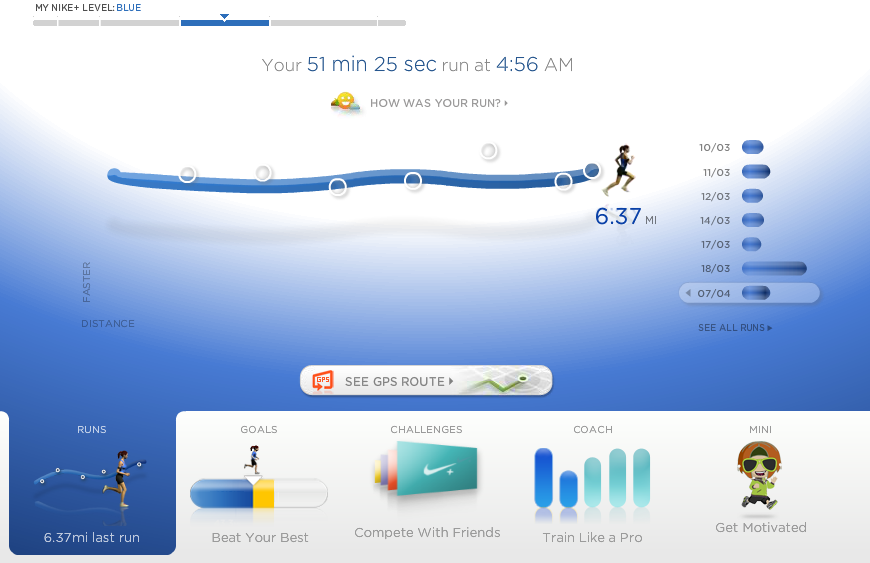
“Gamification” is everyone’s favorite buzzword these days. It’s so hot, that we still use quotes to write it out — “gamification.” Yes, it’s that fresh.
To put it simply, “gamification” is applying game-design thinking to non-game applications in order to make them more fun and engaging. Think Foursquare; you earn points for checking into locations, competing with your network of friends that also use the app for the most points earned through check-ins over a specific period of time.
Outside my role as media maven and gaming publicist, I’m a sweat enthusiast. Yoga, cycling, hiking, I do it all, but my true love is and will always be running. However, sticking to something like an 18-week marathon training program requires a lot of motivation. Enter the “gamification” of running.
I’m an avid Nike+ user. In fact, I’ve been using it for years, long before “gamification” became a part of our daily media consumption. Nike+ uses a sensor to track running distances. The information is then synced online and shared with the Nike+ community and through social media channels like Facebook and Twitter. Users can also set up personal goals for time, distance, or frequency of runs. Additionally, Nike+ has built-in achievement milestones to hit through the program based on total miles run. These levels are broken down by color, going from light to dark. I still get excited each time a legendary runner like Paula Radcliffe congratulates me on hitting a new level.
There are a multitude of similar applications and communities that now serve the same purpose — RunKeeper, MapMyRUN, and TriplePoint’s very own client, Fitocracy. They all help keep runners motivated by providing fun and entertaining ways to keep progressing, whether it’s by hitting achievements, earning points, or sharing completed runs through social networks.
The “gamification” of running. Did you hear that? That was the sound of my worlds colliding.
Hardcore casual gaming: How I learned to stop worrying and love my iPad
I have a confession to make: I was once a biased, prejudiced gamer. I was a zealot on the front lines of a civil war ravaging the United States of Video Gaming. This war wasn’t about the color of a character’s pixels, nor even the content of that character’s coding – it was over the definition of a video game.
I thought that video games were played on corporate-designed consoles and overclocked PC towers of graphical prowess. I was of the belief that a game had to have hours upon hours of immersive content and require a controller, joystick, or other peripheral.
Then, I bought an iPad. I had just joined TriplePoint PR and would be working to help launch a number of iOS games. With newly acquired iOS device in hand, I started digging into the world of mobile games. My assumption was that I would find a market flooded with cute, cartoony, physics and puzzle-based games that wouldn’t hold my attention for more than 10 or 15 minutes each. Boy, was I wrong. Continue reading Hardcore casual gaming: How I learned to stop worrying and love my iPad
Come for the food, stay for the games—an interview with Joystiq Editor-in-Chief Ludwig Kietzmann
While the concept of “media relations” is just one of many key aspects within the world of PR, it is undoubtedly a more crucial component. However, in all our time speaking with journalists and setting up interviews, we seldom get the chance to really question those editors back in a formal Q & A of our own. After agreeing to an interview because he’d “love to inflict transcription on someone,” I had the chance to catch up with Joystiq Editor-in-Chief Ludwig Kietzmann over a San Franciscan brunch where, between delicious cinnamon French toast bites, we discussed his views on where the games industry is going and how PR pros can get his attention. And one more thing, journalists, this transcription thing you all do—I tip my hat off to you.
David: Thank you for taking the time to chat, I’m sure you’re very busy. You are busy, right?
Ludwig: Umm…I don’t think I have anything to do today. I was going to do my laundry; I probably wanted to clean my apartment.
D: Were you going to do anything with the website at all?
L: What website? Oh crap, that thing… I better go.
D: Well first off, you’re brand new to San Francisco in a sense. You’ve been here how long now?
L: Well I’ve been here multiple times through 6 or 7 years, I usually cover GDC, so I’m familiar with the city but this is my first time living in it. I’ve been living here for about two months and, in one of those months, in the apartment that I’m going to stay in forever.
D: Forever? Sounds like you’ve staked out your district, very cool. Why San Francisco? You came all the way from South Africa, you could have went to New York.
L: I could have. I could have gone to any place in the middle of U.S—Chicago. I could have gone to Las Vegas or Miami. San Francisco seems like the obvious choice because it’s really the industry hot bed. I mean I think there’s a lot of contacts here, a lot of events, a lot of coworkers… oh yeah Dave Hinkle – he works here, it’s nice to have some back up for him rather than have him cover everything.
D: Dave Hinkle… I don’t know about that guy sometimes [laughs].
L: I don’t know, I’m getting to know him for the first time now [laughs], and in close proximity. But like I said, it makes sense to me. We needed someone to cover the news cycle in this time zone because we try to have this side updated throughout most of the day. It slows down obviously when everyone goes to sleep, that’s really convenient. And the city, it’s one of my favorite cities in the U.S. Of all the major cities I’ve visited, I really like this one. I like the weather. I like the architecture, the very nature of the neighborhoods.
D: You’ve been in this… game, as it were, for quite a long time. What are some of the favorite types of games you like to review? What are your favorite genres, if you had to pick a few?
L: I like a lot of genres. I wouldn’t specifically lock myself down to specific stuff because, usually, I’ll be interested in certain aspects of all kinds of games. I find it that the games that are most fun to review are the ones that are sort of middle-of-the-road. We could sit down and write a dashing review like, “Oh my God this game is amazing. It blew my mind, it blew all parts of my body, I can’t believe that the amazing stuff of this game is almost perfect.” Or the game was like, you slam it because you hated it, you hated everything about the game. Those kinds of reviews come out really easily but the ones that are, you know, a little bit more mixed, you really have to think about what you’re going to say. How are you going to convey what’s good and what’s bad about it, sort of give the game a fair chance to be judged whether or not it was successful or what it wanted to do. Those games are the most interesting to review, and those are usually my favorite games—ones that are bold but imperfect. D: What is it that you would want to see more of from developers and publishers, from a journalistic standpoint? What can they do to help you guys do your job? And also from the development side, is there anything that you would like to see that hasn’t been done yet or something that you don’t see enough of?
D: What is it that you would want to see more of from developers and publishers, from a journalistic standpoint? What can they do to help you guys do your job? And also from the development side, is there anything that you would like to see that hasn’t been done yet or something that you don’t see enough of?
L: If they want to make my job easier, they would let down some of the barriers. There are many channels you need to go through, which are very regulated and strict and slow. Giving us the access to games and inviting us to studios, showing us how the game is made—we don’t necessarily have to write about everything, we aren’t looking for every single little detail to throw on our front page—we want context and see how a game is shaping up; it increases our understanding of the game. That’s how Hollywood works; Hollywood doesn’t keep quiet about certain aspects of the movie. Like “we can’t tell you who is the actor, we know who it is, but we aren’t going to announce it until two weeks before the movie comes out.” That never happens with Hollywood. They are excited to talk about their movie. I want game development to be like that, more open so that we can see stories that are interesting, have some more transparency so that we can spot those things and write about them and aid the profile of the game; I think that’s a win-win scenario.
As for development, I think the biggest danger facing popular big-budget games right now is that it’s sort of designed by a committee. I feel like there are so many factors that need to be considered in terms of budget, and reach, and satisfying the audience. Studios are almost too terrified to try things that might rub ten percent of the players the wrong way. What may have been an interesting idea gets watered down because there is a need to placate everyone. That pipeline of game design which goes through a bunch of people who test the game and make sure that everyone will be happy with it—that makes a good game, it makes for a good game design, it’s important but you could really stomp some of your passionate ideas flat though. You lose out on spikes, and I think games with spikes that maybe rub you the wrong way sometimes will make you feel some kind of emotions whether it’s frustration or elation. That’s something that you lose when you smooth it all out and put it on a nice curve. Those games are valuable, but I think that the expensive crazy ideas are something that will eventually lose. We’ll see [crazy ideas] in indie games…
D: Definitely. There’s been a huge surge of those in the last couple of years. We’ve seen Limbo, Braid, we have Fez coming out, there’s a lot of creativity out there from a lot of developers that aren’t afraid to try things because they don’t have that high budget. They also don’t have those fans.
L: Exactly. The only studios that maybe don’t get enough credit for making crazy big budget games are some of the Sony studios, like The Last Guardian and Shadow of the Colossus. Those are unusual ideas to be spending a ton of money on. Mass Effect, I think, deserves more credit because they are spending a lot of money…
D: Are you saying they don’t get enough already [laughs]?
L: They are spending a lot of money on things that players might have not even seen. That is the most impractical kind of game design that there is. I would be very surprised if we kept seeing games like Mass Effect, like especially to that scale. Ubisoft Montreal, honestly, they do a lot of sequels but one of their games is a historical action game with multiplayer. You know, Assassin’s Creed. Yes, it’s a popular franchise but, in the grand scheme of things, it’s a very unusual concept and they went with it and that is something to be celebrated. D: Tell me, what is the most outrageous pitch you’ve ever received? There’s got to be one out there.
D: Tell me, what is the most outrageous pitch you’ve ever received? There’s got to be one out there.
L: You know, there was one recently where someone pitched us interviewing Vern Troyer because he’s a gamer, he can totally talk about games—he has opinions about games, “wouldn’t that be fun to talk about on Joystiq dot com?”
D: So does Ice-T!
L: Right, so does everyone who’s played a game. But because they’re a celebrity now it becomes a pitchable thing.
D: But he is probably the shortest person you might have interviewed.
L: Oh, you know, I should have gotten him because I definitely want to interview someone who is shorter than I am. For once.
D: Where is the game industry headed right now? There’s been a lot of news lately, what are some of the trends that you’re seeing? How do you think gaming will evolve as an industry within the next 5 years?
L: Umm, I think better graphics—I’m kidding. Better algorithms, cooler AI… no, kidding. What’s going to happen I think is that we’ll see a lot more established franchises transition into venues that you don’t normally associate them with, like iPhone—which is a super wide platform—free-to-play stuff, casual-oriented stuff… you’ll see that happening because I think the elephant in the room of the game industry, as it were, is that there are way too many games and you run into the point where there’s a limited pool of resources from your customers that only have X number of hours and X number of dollars in their bank account. Whenever someone buys a sixty dollar game it means they’re not buying the four other games that came out on the same day, and that just isn’t sustainable. And that’s why you’re seeing studios going under, like Bizarre and Black Rock Studio, because that sort of system is rejecting them even though they still have good products and the critical acclaim is there, and even sometimes the marketing is there yet it doesn’t work because you’re just dealing with limited resources.
D: And too many choices.
L: And that’s the problem, the industry is sort of almost over-delivering for the needs of the players and if they could just scale back—not necessarily the ideas—but just scale back in terms of the quantity of games they put out and that some executive approves, because they think it’s a hole that needs to be filled in the market… that’s the problem, that’s why platforms like iPhone are ultra-wide and easily accessible to many people who are more supportive of more games. I don’t think you’ll ever lose hardcore games because the people who make them want to make those kinds of games, you know, just as a creative impulse.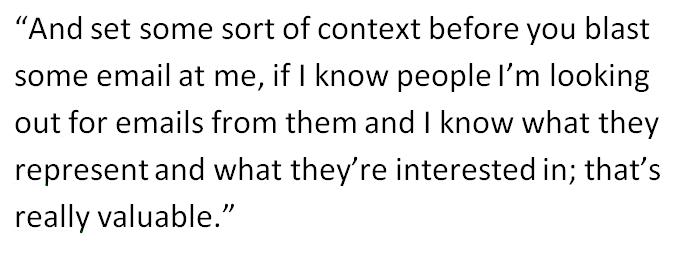
D: So for the PR pros out there, what kinds of subject lines get your attention? Is my “all caps and lots of exclamation points” system not working out for you?
L: [laughs] So, here’s an important thing—and you’ll be surprised that this does not always happen—having a game title in the subject line. I need to know that I’m reading about a game, I need to know that immediately. I think subject lines that are tailored to me, and by people who understand what Joystiq usually covers, that’s how you’ll get our attention. We get a lot of headlines and stuff, or emails and pitches, of things that if someone had read [Joystiq] they would know that we would never write about it.
D: Any examples that you can think of off the top of your head?
L: Like movies, I get stuff about movie stars being in town and if I’d like to interview them and I’m like “well no,” obviously, because we don’t do that. We have a hardcore focus on Joystiq so I think that should guide pitches coming in. Having a prior connection with a public relations person also helps a lot, don’t just kick down my door with a pitch immediately, introduce yourself and tell me who you are and what kinds of games your company is dealing with…
D: You mean, have manners and be proper?
L: Right! And set some sort of context before you blast some email at me, if I know people I’m looking out for emails from them and I know what they represent and what they’re interested in; that’s really valuable. And if you’re wacky, just make sure that you’re not so wacky to the point where it becomes hard to decipher any information from your email.
D: Well that’s about it, thanks for your time! Anything else you’d like to add?
L: Be optimistic! Exclamation point!


